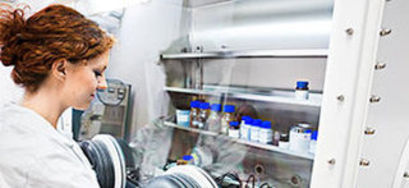The German-Ukrainian project HOTWIN, which was completed at the end of November 2015, focused on developing new kinds of materials intended for the mentioned applications and for other uses. At the moment, nickel-based superalloys are normally used, which can withstand maximum application temperatures of around 1100°C. Applications at even higher temperatures become possible by using high-melting-point metals, so-called refractory metals.
Target: enable use at higher temperatures
The project, which ran for two years, was aimed at manufacturing such refractory metals, such as molybdenum, wolfram and chromium, directly in only one process step using inter-metal or ceramic strengthening elements based on a mixture of elementary powders in the zone-melting process. This process influenced the size and distribution of the material components in a targeted manner based on manufacturing parameters.
The successfully manufactured new materials will make a contribution to increasing efficiency and as such to more economic operations of technical aggregates, e.g. of gas turbines for energy generation and aeroplane engines. This means that more options will be available in future in terms of various technical high-temperature applications.
Ukrainian-German cooperation
The new high-temperature materials were developed in a German-Ukrainian cooperation. The cooperation was characterised by the complementary expertise of the project partners: The Ukrainian partner provided a zone melting oven designed specifically for such high-melting-point materials, which made it possible to manufacture the material compositions envisaged by the German partner. The German partner contributed its expertise by outlining the relationship between the microstructure and the mechanical properties at high temperatures up to 1400°C. The intensive involvement of young scientists from the two partner institutions offered particular added value.
Special results and successes of the measure
The no-cup zone melting method used is excellently suited to the manufacture of high-temperature materials because reactions with the smelter can be excluded at melting temperatures above 2000°C and the materials created can be kept free from impurities. The extremely pure materials created are highly stable and reliably solid at temperatures up to 1400° C.
The bilateral project laid the scientific foundations for the efficient manufacture of high-temperature materials with strengthening structures. The technical results add high-performance, high-temperature-resistant alloys to the known range of materials.
Find out more on the HOTWIN website.
Contact
Dr Thomas Reineke
DLR Project Management Agency
European and International Cooperation
Tel: +49 228 3821 1448
thomas.reineke@dlr.de
Jun.-Prof. Dr.-Ing. Manja Krüger
Magdeburg University
Institute for Material and Joining Technology
Tel: +49 391 67 14516
manja.krueger@ovgu.de








